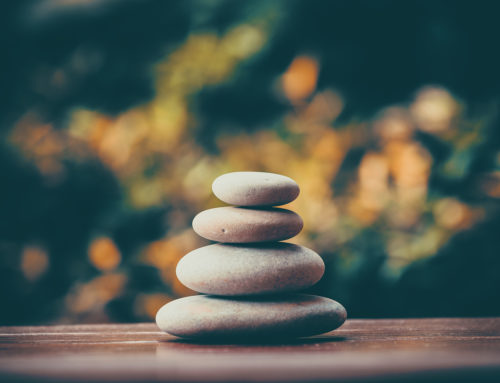Touch Drawing as a tool for creative self-reflection and connection.

In graduate school, although my focus was Clinical Psychology, I had the good fortune of being able to take electives from other departments. Out of all of the electives I took, the one that had the most lasting effect—and still informs my mindful creativity practice—was Touch Drawing, taught by the ever-inspiring Deborah-Koff Chapin.
Touch Drawing is a practice Deborah discovered in the 1970s and now teaches all over the world. The practice is relatively simple and needs just a few special supplies, including a melamine board (much like a dry erase board), water based oil paints and a brayer. You will also need lightweight paper that can stand up to the oil paints.
To engage in the Touch Drawing process, begin by taking your board and putting a small amount of paint on it. Roll the paint evenly and thin. Then lay a piece of paper on top of the paint. Once this process is complete, hands are your only tools—no other equipment needed.
Place your hands on the paper. Where ever you make contact with the paper, a mark is made on the opposite side. You can get different textures depending on how much pressure or what part of your hands you use (fingernails make a very different mark than your palms, for example). The practice is simple, can be brought just about anywhere and is inexpensive. It also feels a bit like finger painting for grownups, which can help us all-too-busy adults access the joy and lightness of younger days.
In Deborah’s class, we went through a series of practice sessions, which involved each of us sitting with our boards and supplies and making drawings. There were no other requirements or other assignments. We were encouraged to take our time and honor whatever came up in us. The only thing Deborah discouraged was allowing ourselves to get too stuck. Part of the beauty of this practice is that there are no boundaries and you can just keep going. The idea is to let go of outcome, take it slowly and savor the process.
The thing struck me then about Touch Drawing—and still does today—is how the process makes it easier for me to reject the self-critic. While creating a touch drawing, all you can see is the back of the picture so you can’t really critique it during the creative process. Also, everything is in reverse and many of the nuances that you see when you peel the paper off cannot be viewed from the back. So, you just sort of have to let it go and keep trying. There is no room for any self-criticism or self-doubt. Touch Drawing is also a great way to work through creative blocks and to keep having conversations with ourselves. There really is no goal or outcome aside from creating.
Today, as a clinical psychologist and life coach with an emphasis on mindfulness, one of my favorite ways to engage in touch drawing is as a mindfulness art practice. I now find the practice to be sort of like journaling, but without words and a great way to self-explore and reflect. The images below were made during a period of my life when I was trying to access a feeling of personal power. I knew I wanted to feel more empowered as a woman, but I wasn’t sure how to get there. Before engaging in the touch drawing process, I sat quietly, trying to recall memories from my past when I felt a sense of my own personal power. I brought those memories to mind and tried to revisit the feelings I experienced then, even if they were only tiny shades of what I hoped to feel in the future. Once I had a hold of the feeling, I expressed it through a gesture. Putting hand to paper, I would create a mark. I would then open my eyes and look at it. I would try to respond to what I saw by adding to the paper. After a few minutes of reflection, I would start again with another sheet of paper. Through the course of this practice, I gained the insight I needed to access a deeper sense of self-confidence and personal power than I had ever felt before.

How To Create Your Own Mindfulness Art Touch Drawing Practice
If you want to try this yourself, I recommend you attend a workshop or class with Deborah Koff-Chapin. If that’s not an option, visit The Center for Touch Drawing website for more information about the practice and how to do it. Once you have your supplies, you are ready for the practice. Prepare your board and your supplies and find yourself a space and time in which you are unlikely to be interrupted.
Start with a basic mindfulness meditation practice. Tune in to your senses and hang out in the present moment for a few breaths without getting too lost in thoughts. Once you feel grounded, bring to mind an issue in your life that you would like more clarity on. Invite that subject to enter into your awareness and notice your response to it. Tune into whatever feelings come up, bringing curiosity to the experience. Try to avoid interpretation or thoughts. It’s easy to tell when you are lost in thoughts. If words enter into your awareness, you’ve moved from the direct experience to interpretations of it.
You can engage in the process solo or with partners. One of the greatest strengths of Touch Drawing is that you can communicate, either to yourself or to others, concepts that you haven’t been able to put words to yet. You can start with just an inkling of a feeling. Not only is this wonderful for finding clarity within yourself about areas where you feel stuck or seek growth, it is also a remarkable tool for communicating with other people. In class, I heard stories of profound peace work being done in the Middle East between Israeli and Palestinian women communicating without walls. I heard people talk of beautiful body image work with teenagers, using life sized touch drawing boards and full body images. I have also been astounded by the grief work being done with this medium. Just imagine closing your eyes, remembering your loved one, and how it would feel to caress his or her face. As your hands move across the paper, you end up making an image that resembles, in some ways, the face of your loved one. So much healing work can be done in the space where words don’t exist. With the simple process of Touch Drawing used as a mindfulness art practice, you can tap into yourself, intuitively communicate with others and make personal and collective discoveries.





